TRANSPORTATION IN HUMAN BEINGS
INTRODUCTION: The higher organisms have a highly complex body structure. Various organs are located far away from each other and many have no connections ever. These types of animals have a special type of circulatory system that transports food or nutrients, oxygen and carbon-di-oxide gases, waste products and hormones from one part of the body to another part and also performs functions like regulation of temperature and protection against germs.
Our body also secretes many hormones, which have to be carried to various parts of the body for control and coordination. Thus, the transport of hormones is carried by a transport system in our body.
CIRCULATION IN HUMANS
In human beings, rapid supply of nutrient, oxygen and hormones to various tissues and the immediate disposal of waste products in an essential requirement. So, our body has a specialized circulatory system having three parts:-
a)Circulatory medium:- Blood, lymph and tissue fluid.
b)Blood vessels:- Arteries, veins, and capillaries (a system of tubules through which the blood flows)
c) The central pumping organ:- Heart
In human being as well as all vertebrates have a closed circulatory system in which the blood flows through a system of closed chambers and tubes called heart and blood vessels. Blood does not flow into any open spaces. The strong pumping action of heart makes blood flow rapidly and with pressure in the arteries.
COMPOSITION OF BLOOD
*Blood is a red coloured fluid that circulates in the whole body.
* It looks red in colour due to the pigment haemoglobin present in red blood cells.
* It consists of two components:-
| COMPONENTS | CHARACTERISTICS |
| Plasma (55% of blood) | Fluid part of blood |
| Blood cells (45% of blood) | Three types of cells ( red blood cells, white blood cells, platelets) |
** An adult containds about 5litres of blood. (CIRCULATION OF BLOOD)
BLOOD PLASMA
It is a pale yellow or straw coloured fluid that forms 55% of component of blood. It contains 90% of water and a number of compounds. It also contains a natural anti-coagulant called HEPARIN.
CONTENT OF BLOOD PLASMA
| COMPONENTS | CHARACTERISTICS |
| Water | 90 -92% |
| Plasma proteins | 7 – 8% |
| Inorganic compounds | 1%( salts of various compounds) |
| Food, gases, excretory waste, hormones | 1 -2% |
INCREASED EFFICIENCY OF MAMMALIAN RBCs
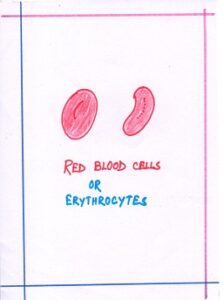
Causes
1)Absence of mitochondria increases the efficiency as RBCs cannot respire or carry out any metabolic activities so these cannot use oxygen. Hence all oxygen they carry is transported to tissue and not utilized.
2)Absence of other organelles like endoplasmic reticulum and centriole increases the space in the cytoplasm which is used to pack more amount of haemoglobin.
3)Absence of nucleus provides more space in RBCs for haemoglobin, so that the molecules can transport more oxygen.
4)RBCs do not divide and have a life span of 120 days hence centriole and other organelles are not needed. They are constantly replaced by new RBCs after that.
5)RBCs do not carry out any metabolic activities like storage or condensation of any molecule which saves energy as well as oxygen.
6)RBCs having a small size and biconcave shape helps them to flow through their capillaries in a single file.
7)Large surface area of RBCs provides more amount of diffusion of gases.
COMPARATIVE STUDY OF DIFFERENT YPES OF BLOOD CELLS
| CHARACTERISTICS | RED BLOOD CELLS (ERYTHROCYTES) | WHITE BLOOD CELLS
(LEUCOCYTES) |
BLOOD PLATELETS
(THROMBOCYTES) |
| 1)SHAPE | Circular and biconcave | Round and irregular | Irregularly shaped,small and fragmented |
| 2)OCCURRENCE OF NUCLEUS | Do not contain nucleus | Have distinct nucleus | Do not conain nucleus |
| 3)COLOUR | Red in colour due to presence of haemoglobin | Colourless as haemoglobin is absent | Colourless as haemoglobin is absent. |
| 4)SIZE | 7-8 µm in diameter | 8-20µm in diametre | 2-4 µm in diameter |
| 5)FUNCTION | Transport oxygen from lungs to tissues. Haemoglobin carries O2 and forms oxyhaemoglobin . hey also help in transporing CO2 from tissues to lungs. | Protects the body against diseases and infections.
It helps in phagocytosis and diapedesis to kill the germs. |
Helps in blood clotting. |
| 6)NUMBER | 4.5-5 million per cubic mm. | 7,000-10,000 per cubic mm. | 2,50,000 per cubic mm. |
| 7)LIFE SPAN | 120 days | Few hours to a few days | 6-8 days |
| 8)ORIGIN | Formed in red bone marrow | Formed in white bone marrow | Formed from fragments of large bone marrow cells. |
| 8)DIAGRAM |  |
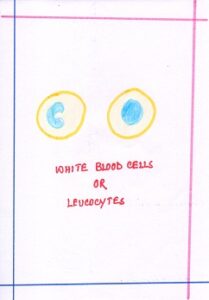 |
 |
WHITE BLOOD CELLS
White blood cells are white due to absence of haemoglobin. It is of two types : granulocytes and agranulocytes. (CIRCULATION OF BLOOD)
| CHARACTERISTICS | EOSINOPHILS (granulocytes) | BASOPHILS (granulocytes) | NEUTROPHILS (granulocytes) | MONOCYTES (agranulocytes) | LYMPHOCYTES (agranulocytes |
| STAINING | Stain red with acidic dye like eosin | Stain blue with basic dye | Stain with neutral dyes | No staining | No staining |
| STRUCTURE | Bilobed nucleus | 2-3 lobed shaped nucleus | Multilobed nucleus | Bean-shaped nucleus | Large oval nucleus |
| FUNCTION | Activate chemicals to fight allergy | Help in defence mechanism of body | Highly phagocytic | Ingest germs and clean up damaged cell | Produces antibodies and play a crucial role immunity |
| DIAGRAM | 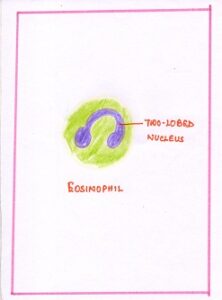 |
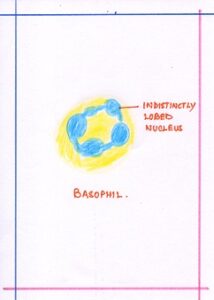 |
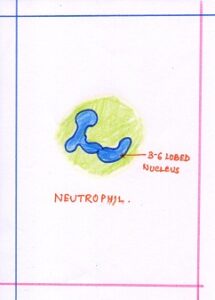 |
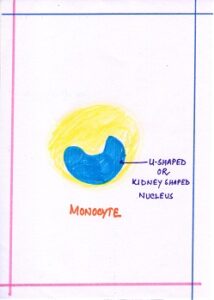 |
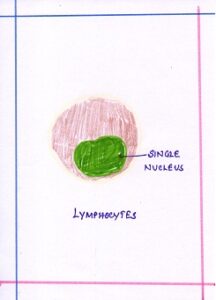 |
DIAPEDESIS ( A UNIQUE FEATURE OF WBCs)
Diapedesis is the ability of white blood cells to pass through intact blood vessel walls. WBCs can squeeze out of the thin single-layered wall of the capillary. Due to this ability of diapedesis the WBCs squuze out of the capillary walls at the place of injury and then they destroy the germs by phagocytosis.
PLATELETS
These are colourless, oval or round cytoplasmic fragments formed from giant cells of the bone marrow. These are found floating in the blood. These are found floating in the blood. These are nucleated or without nucleus bounded by a membrane and contains a few organelles. Their life span is about 5 – 10 days. They release a chemical, thromboplastin which initiates the process of clotting of blood.
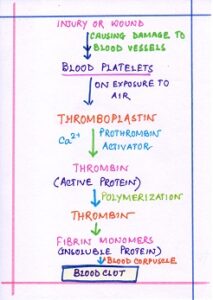
FUNCTIONS OF BLOOD
- Transport of nutrients like digested foods to different parts of body which are absorbed by small intestine .
- Transport of respiratory gases from lungs to the tissues and from tissues to the lungs.
- Transport of waste products to the excretory organs.
- Regulation of body temperature by evenly distributing the heat produced in one part of the body to different parts.
- Defence against infections by phagocytic nature of WBCs which can kill the germs.
- Maintenance of pH by plasma proteins which are amphoteric in nature.
- Water balance to a constant level by bringing about constant exchange of water between the circulating blood and the tissue fluid.
- Clotting of blood by prothrombin and fibrinogen proteins released by platelets. This prevents blood loss.